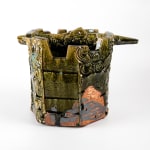Takauchi Shugo 髙內秀剛 b. 1937
H26.6 x W34.2 x D21.5cm
Further images
-
(View a larger image of thumbnail 1
)

-
(View a larger image of thumbnail 2
)

-
(View a larger image of thumbnail 3
)

-
(View a larger image of thumbnail 4
)

-
(View a larger image of thumbnail 5
)

-
(View a larger image of thumbnail 6
)

-
(View a larger image of thumbnail 7
)

-
(View a larger image of thumbnail 8
)

-
(View a larger image of thumbnail 9
)

-
(View a larger image of thumbnail 10
)

-
(View a larger image of thumbnail 11
)

-
(View a larger image of thumbnail 12
)

-
(View a larger image of thumbnail 13
)

Emerging from the Mashiko scene in Tochigi during the early 1970s, TAKAUCHI Shugo (b. 1937) ascended to fame in his craft when he was selected in 1972 for the Japan Traditional Crafts Exhibition. His profound grasp of Kogei philosophies underscores his mastery of a diverse range of glaze types. He has showcased his works at prestigious venues such as the National Museum of Modern Art in Tokyo, the Tokyo Metropolitan Teien Art Museum, created pieces dedicated to his Buddhist practice at the Yakushiji Temple in Nara, and held numerous solo exhibitions at Mitsukoshi Nihonbashi and Takashimaya. Internationally, his work has found a permanent place in the collections of renowned institutions like the Metropolitan Museum of Art and the Brooklyn Museum of Art, among others.
Despite his remarkable repertoire, Takauchi has led an unconventional life as a potter. He served as a salaryman in corporate Tokyo before relocating to Mashiko to construct his kiln, employing both gas and wood firing methods in 1968 after finding inspiration in the works of Hamada Shoji. This unconventional background has endowed him with the capacity to transcend the stylistic regionalism that characterized Kogei styles in the ceramic art industry from the 1940s to the 1970s. His expertise extends across a broad spectrum of glazes. This piece is a testament to his mastery and exploration of the beloved Oribe-yaki glaze from the Mino region.
In this Oribe water jar with a handle, he has embraced a more solemn and geometric interpretation of the decorative styles of Oribe, which traditionally lean towards playfulness and whimsy, as seen in the works of Suzuki Goro. Near the jar's flat base, an image evokes a rising round red moon obscured by darkened clouds, evoking motifs of water, the intended content of the jar. The dark patterning and the suggestion of rain in the form of storm clouds are complemented by undulating shades of light and dark green that cascade down the surface of the jar's straight and robust body. This piece eloquently conveys the essence of an evening rain.
The jar is enclosed with its original signed wooden box, and a signature at the base.












